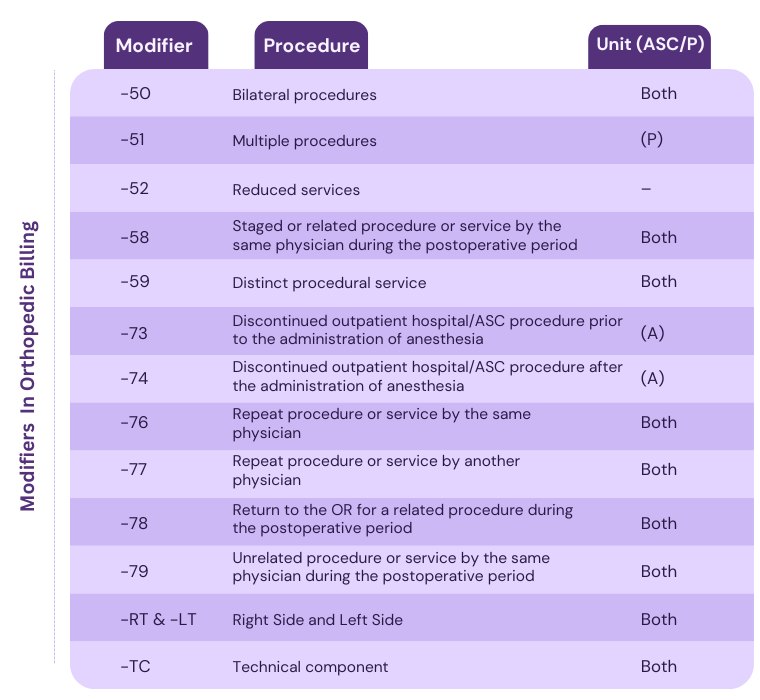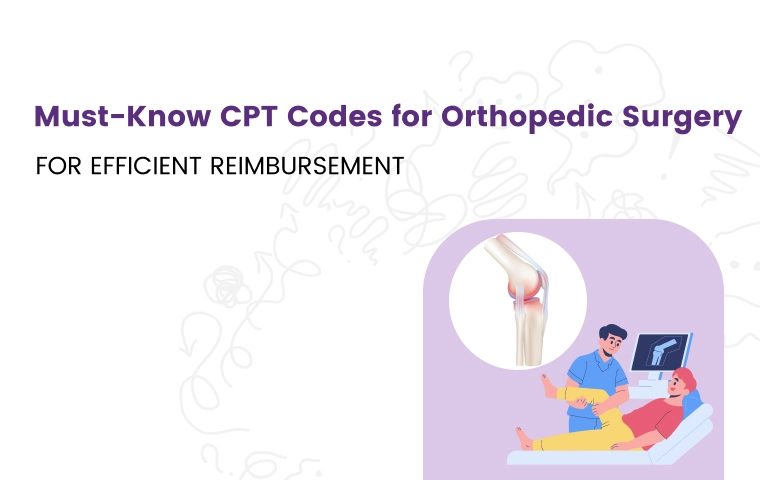Have you ever felt lost in the maze of billing codes after a day of performing surgeries? You're not alone. The world of orthopedic surgery is complex enough without the added puzzle of CPT codes.
This blog is designed to cut through the complexity, offering you a clear guide to the essential CPT codes that are key to efficient reimbursement. With this knowledge, you can focus more on what you do best — caring for your patients.
Essential CPT Codes for Orthopedic Billing
While numerous CPT codes fall under the umbrella of orthopedic surgery, understanding these core categories provides a solid foundation:
-
Evaluation and Management (E/M): These codes (99201-99499) represent the physician's evaluation and management services, encompassing the time and complexity involved in examining the patient, establishing a diagnosis, and developing a treatment plan.
-
Anesthesia: Codes in this range (00100-01999 and 99100-99140) represent the services rendered by the anesthesiologist, covering pre-operative evaluation, administering anesthesia during surgery, and monitoring the patient's vital signs throughout the procedure.
-
Surgical Procedures: This extensive range (10021-69990) encompasses the vast array of surgical procedures performed by orthopedic surgeons, from simple repairs to complex joint replacements.
-
Radiology: These codes (7010-79999) represent imaging services like X-rays, MRIs, and CT scans, often crucial for diagnosing and monitoring orthopedic conditions.
-
Pathology and Laboratory: Codes in this category (80047-89398) represent laboratory tests and pathology services performed on tissue samples, aiding in diagnosis and treatment planning.
-
Medicine: This category (90281-99299 and 995001-99607) covers various medical services not categorized elsewhere, such as injections, medication administration, and wound care.
CPT Codes for Common Surgical Orthopedic Procedures
While understanding the core CPT code categories is crucial, delving deeper into specific codes used in standard orthopedic procedures can equip you with even more excellent knowledge. Some frequently encountered procedures and their corresponding CPT code ranges:
The Upper Limb:
-
Shoulder Surgery (23000-23929): This range encompasses various procedures on the shoulder joint, including rotator cuff repairs, arthroscopic surgeries, and joint replacements.
-
Humerus (Upper Arm) and Elbow Surgery (23930-24999): This range covers procedures on the upper arm bone (humerus) and the elbow joint, including fracture repairs, ligament reconstructions, and tendon repairs.
-
Forearm and Wrist Surgery (25000-25999): This range includes procedures on the forearm bones (radius and ulna) and the wrist joint, such as carpal tunnel release, fracture fixation, and tendonitis treatment.
-
Hand and Finger Surgery (26010-26989): This comprehensive range covers various procedures on the hand and fingers, including trigger finger release, tendon repairs, and fracture fixation.
The Spine:
-
Spinal Surgery (Vertebral Column) (22010-22899): This extensive range encompasses a wide array of procedures on the spine, including fusions, disc replacements, and decompression surgeries.
Hand Surgery:
-
Repair of Nail Bed (11760)
-
Carpectomy, all bones of proximal row (25215)
-
Neuroplasty and/or transposition; median nerve at carpal tunnel (64721)
Carpal Tunnel Release:
-
Open Carpal Tunnel Release (64721): As mentioned earlier, this code, within the 25000-25999 range, represents the traditional open surgical approach for carpal tunnel release.
-
Endoscopic Carpal Tunnel Release (29848): This minimally invasive technique using an arthroscope falls under the 29800-29999 range, dedicated to arthroscopy procedures.
Bundling and its Impact:
It's important to understand the concept of bundling in relation to CPT codes. Bundling refers to the situation where specific services are considered inherent to, or included within, the main procedure code. For example, consider meniscectomy codes:
-
Arthroscopic Meniscectomy, Medial Meniscus (29870): This code, in the 29800-29999 range, represents the arthroscopic removal of a torn portion of the medial meniscus in the knee. However, it is bundled with:
-
Arthroscopy, Knee (29850): This bundled code signifies the arthroscopic visualization of the knee joint, considered an inherent part of the meniscectomy procedure and residing in the same 29800-29999 range.
-
Therefore, understanding bundling is essential to avoid billing for services already included within the primary code, preventing potential claim denials and ensuring accurate billing practices.
Understanding Global Periods In Orthopedic Billing
It's important to note that not all surgical procedures carry the same global period. While major surgeries typically have a 90-day global period (including a 1-day pre-operative period), minor procedures may have shorter periods or no global period at all.
For example, a total knee replacement would typically fall under the 90-day global period, with the reimbursement for the surgery encompassing the initial pre-operative evaluation, the surgery itself, and subsequent post-operative care for the following 90 days. In contrast, a simple removal of a foreign body from the hand might have no global period, meaning separate billing would be necessary for the procedure and any follow-up visits.
Modifiers In Orthopedic Billing
modifiers act as crucial additions, offering supplementary details about the specific circumstances surrounding a procedure. These modifiers ensure accurate and complete communication between healthcare providers and payers, ultimately impacting reimbursement.

New Additions and Clarifications for 2024 In Orthopedic Billing
The CPT coding system undergoes annual updates to reflect advancements in medical technology and treatment procedures.
New Codes for Vertebral Body Tethering (VBT):
-
Category I Codes:
-
22836: Anterior thoracic vertebral body tethering, including thoracoscopy (up to 7 vertebral segments).
-
22837: Anterior thoracic vertebral body tethering, including thoracoscopy (8 or more vertebral segments).
-
22838: Revision, replacement, or removal of thoracic vertebral body tethering, including thoracoscopy.
-
These new codes address the growing demand for VBT, a minimally invasive procedure used to treat adolescent idiopathic scoliosis.
-
Category III Code:
-
0790T: Revision, replacement, or removal of thoracolumbar or lumbar vertebral body tethering, including thoracoscopy.
-
This code caters to procedures involving the thoracolumbar or lumbar spine, complementing the new Category I codes for the thoracic region.
Revised Codes for Bunion Correction:
Changes have been made to clarify the reporting of procedures related to bunion correction (hallux valgus). The word "with" has been added to the following codes:
-
28292: Correction, hallux valgus with (bunionectomy), with sesamoidectomy, when performed.
This emphasizes that codes 28292 and 28295-28299 inherently involve the removal of the bunion.
Clarification for First Tarsometatarsal Joint Fusion:
Parenthetical notes have been added to codes 28740 and 28297, specifying that code 28740 should be used for first tarsometatarsal joint fusions that do not include bunion removal for hallux valgus correction.
New Category III Code for Percutaneous Injection:
-
0814T: Percutaneous injection of calcium-based biodegradable osteoconductive material, proximal femur, including imaging guidance, unilateral.
This code signifies the introduction of a new procedure involving the injection of bone-forming material into the proximal femur for patients with conditions like osteoporosis.
Words By Authors
For orthopedic surgeons and billing professionals alike, staying abreast of CPT codes is not merely a matter of regulatory compliance but a commitment to ensuring the best possible outcomes for patients and practices. As we navigate these codes, we not only pave the way for efficient reimbursement but also uphold the integrity and advancement of patient care. Whether you're a seasoned orthopedic surgeon or new to the field, embracing the complexity of CPT codes is a step towards a more informed, efficient, and patient-centered practice.
ABOUT AUTHOR

John Wick
As a blog writer with years of experience in the healthcare industry, I have got what it takes to write well-researched content that adds value for the audience. I am a curious individual by nature, driven by passion and I translate that into my writings. I aspire to be among the leading content writers in the world.
